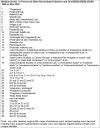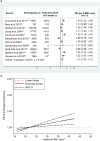Maternal body mass index and post-term birth: a systematic review and meta-analysis
- PMID: 28085991
- PMCID: PMC5324665
- DOI: 10.1111/obr.12489
Maternal body mass index and post-term birth: a systematic review and meta-analysis
Abstract
Post-term birth is a preventable cause of perinatal mortality and severe morbidity. This review examined the association between maternal body mass index (BMI) and post-term birth at ≥42 and ≥41 weeks' gestation. Five databases, reference lists and citations were searched from May to November 2015. Observational studies published in English since 1990 were included. Linear and nonlinear dose-response meta-analyses were conducted by using random effects models. Sensitivity analyses assessed robustness of the results. Meta-regression and sub-group meta-analyses explored heterogeneity. Obesity classes were defined as I (30.0-34.9 kg m-2 ), II (35.0-39.9 kg m-2 ) and III (≥40 kg m-2 ; IIIa 40.0-44.9 kg m-2 , IIIb ≥ 45.0 kg m-2 ). Searches identified 16,375 results, and 39 studies met the inclusion criteria (n = 4,143,700 births). A nonlinear association between maternal BMI and births ≥42 weeks was identified; odds ratios and 95% confidence intervals for obesity classes I-IIIb were 1.42 (1.27-1.58), 1.55 (1.37-1.75), 1.65 (1.44-1.87) and 1.75 (1.50-2.04) respectively. BMI was linearly associated with births ≥41 weeks: odds ratio is 1.13 (95% confidence interval 1.05-1.21) for each 5-unit increase in BMI. The strength of the association between BMI and post-term birth increases with increasing BMI. Odds are greatest for births ≥42 weeks among class III obesity. Targeted interventions to prevent the adverse outcomes associated with post-term birth should consider the difference in risk between obesity classes.
Keywords: BMI; gestational age; maternal; obesity.
© 2017 The Authors. Obesity Reviews published by John Wiley & Sons Ltd on behalf of World Obesity.
Figures




References
-
- Spong CY. Defining “term” pregnancy: recommendations from the defining “term” pregnancy workgroup. JAMA. 2013; 309: 2445–2446. - PubMed
-
- Flenady V, Koopmans L, Middleton P et al. Major risk factors for stillbirth in high‐income countries: a systematic review and meta‐analysis. The Lancet. 2011; 377: 1331–1340. - PubMed
-
- Caughey AB, Musci TJ. Complications of term pregnancies beyond 37 weeks of gestation. Obstetrics & Gynecology. 2004; 103: 57–62. - PubMed
-
- Shea KM, Wilcox AJ, Little RE. Postterm delivery: a challenge for epidemiologic research. Epidemiology. 1998; 9: 199–204. - PubMed
-
- Mandruzzato G, Alfirevic Z, Chervenak F et al. Guidelines for the management of postterm pregnancy. Journal of Perinatal Medicine. 2010; 38: 111–119. - PubMed
Publication types
MeSH terms
Grants and funding
LinkOut - more resources
Full Text Sources
Other Literature Sources
Medical
Miscellaneous

